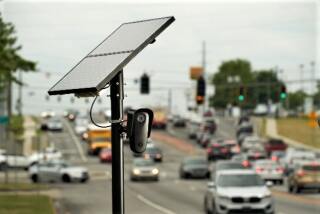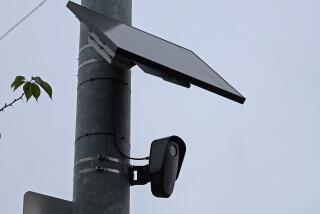Video Printer Gives Police a Better Shot
- Share via
LANCASTER — A gunman holds up a convenience store or bank and before he escapes with the loot, his likeness is captured by surveillance cameras, which some people may believe will lead to the culprit’s quick arrest.
Not so, say law enforcement officials.
One of the problems in finding criminals photographed by surveillance cameras has always been getting their picture to officers or deputies on the street.
Because squad cars are not issued videotape monitors--at least not yet--mug shots have to be made from videotapes and then distributed, which has always been very time consuming, Los Angeles County sheriff’s officials said.
“It used to take days to get pictures back,” said Lt. Tom Pigott of the Lancaster sheriff’s station.
“We used to send [surveillance] tape to the crime lab downtown to get processed and we got the mug shots back depending on how heavy the lab’s workload was.”
But last month, the Lancaster station was the first in the department to obtain a new system that will put pictures of wanted criminals in the hands of deputies within hours of a crime.
The $1,000 “frame grabber” system, donated by the Lancaster sheriff’s booster club and Target Inc., will make darkrooms and long processing delays part of the past.
Prints take only minutes to develop with the frame grabber. It looks like a simple home-entertainment center with a regular television monitor sitting atop a specially designed VCR and printer.
And operating the system is as easy as programming a VCR, Pigott said. (And he meant that without sarcasm.)
A deputy watches the monitor, searching a videotape for a scene that offers a clear, full view of the criminal’s face.
The VCR, which is designed to freeze frames even on high-speed film, can stop the tape precisely where the deputy wants.
Once a button is pushed, the printer takes a picture of the selected frame and develops a black-and-white print in less than five minutes.
“It’s not something you have to go to school to learn,” said Pigott, who added that about a dozen of his detectives already know how to operate the system. “It takes five minutes to learn.”
But there are also downsides to the new system. Like the old processing methods, the Frame Grabber relies heavily on the quality of the videotape.
“If the surveillance tape is fuzzy, then the prints we make will be fuzzy too,” Pigott said. “Most of these convenience stores and ATM machines rewind their tape and use it day after day. The quality gets very poor over time. If they used new film every week or so, we could make better prints when we needed to.”
Another problem with the system is that it costs $1 for every print. That means every time a bandit’s picture is passed out, the station could spend $50 to $100.
Pigott said costs could be kept down by making a single print and photocopying it for circulation, but again the quality would be diminished.
“It’s not a piece of equipment we’ll use every day but it’s nice to know we have it when we need it,” he said.
Pigott and his detectives think having a picture of a suspect while he may still be near the crime scene is worth the expense.
More to Read
Sign up for Essential California
The most important California stories and recommendations in your inbox every morning.
You may occasionally receive promotional content from the Los Angeles Times.










